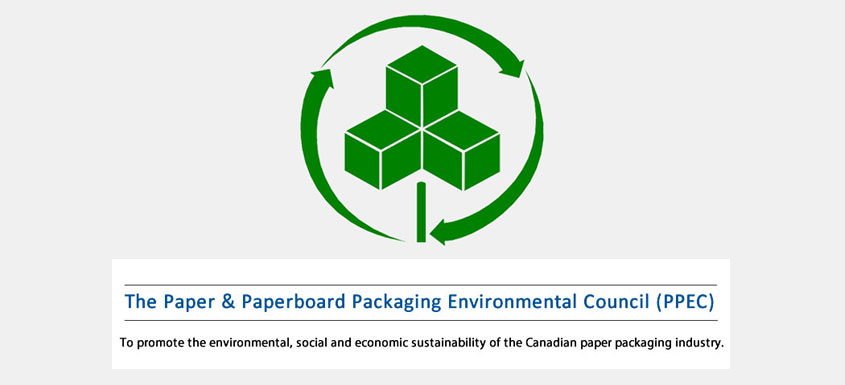As the Paper and Paperboard Packaging Environmental Council (PPEC) continues to work on achieving its mission to promote the environmental, social, and economic sustainability of the Canadian paper packaging industry, we will also be closely monitoring the following key issues in 2022.
Extended Producer Responsibility and Recycling
Extended Producer Responsibility (EPR) is a policy approach in which a producer – a business that makes or sells obligated materials – is made financially responsible for ensuring their products and packaging are properly managed at the end of their life.
In Canada, EPR recycling programs for residential packaging and printed paper (PPP) are currently legislated in British Columbia, Saskatchewan, Manitoba, Ontario, and Quebec.
While PPEC members have not historically been obligated stewards of these programs – our members typically engage in business-to-business transactions, and do not directly supply finished products to consumer – such recycling programs are critical to our industry, and on behalf of its members, PPEC participates in government discussions related to new or changing recycling regulations.
This year will be busy with changes to existing programs and new government consultations, and PPEC will be closely monitoring:
- Ontario as the Blue Box program transitions to a full producer responsibility model, regulated in June 2021, which means it is moving to a full 100% operational and financial management model, with implementation beginning July 2023. Under the previous regulation, producers were responsible for funding 50% of program costs; while the new model requires producers to establish and fund a collection and management system to manage Blue Box materials.
- Alberta introduced the Environmental Protection and Enhancement Amendment Act which will enable the development of EPR regulations for designated categories of materials. The government is currently conducting a stakeholder consultation.
- New Brunswick amended the Designated Materials Regulation under the Clean Environment Act in October 2021, to establish an EPR program for packaging and paper products. Recycle NB will oversee the PPP program, and under the amended regulation, brand owners are required to register with Recycle NB by February 11, 2022. The program is proposed to begin in the spring of 2023.
- Nova Scotia introduced The Environmental Goals and Climate Change Reduction Act, which includes a provision to develop and legislate an EPR program for paper and packaging in Nova Scotia, with new EPR regulations expected to be developed by 2023. A 90-day government consultation is expected to launch in early January.
- Quebec will begin its transition period to an EPR model for its curbside recycling system in 2022, with implementation by 2025. Companies who already finance the Quebec curbside recycling system will be given control over its the system and its management, in partnership with municipalities. Under the current system, companies finance 100% of the costs of municipal collection services for recyclable materials, without control over system management.
- Manitoba’s PPP stewardship organization, Multi Material Stewardship Manitoba (MMSM), submitted the draft Transition Plan to Minister of Conservation and Climate November 2021, outlining how it proposes to transition the current shared responsibility model for the delivery of residential recycling of PPP, to one that is fully operated and financed by industry. It is expected that there will be additional consultations this year.
PPEC is proud that paper-based packaging is highly recyclable across Canada in provincially legislated Blue Box-type programs. Not only do Canadian residents have access to these programs, but they actively recycle their paper-based packaging, allowing PPEC’s paper packaging mill members to maintain high levels of recycled content in Canadian made paper packaging, illustrating our home-grown circular economy where used paper is recycled again and again.
New Forestry Statistics
Sustainable forest management is a fundamental pillar for PPEC and its members and is essential to the Canadian paper-based packaging industry.
While most paper packaging made in Canada is made with recycled content, the paper fibres it was originally made from came from a tree. However, less than half of one per cent of Canadian commercial forests are harvested for paper-based packaging, and every hectare that is harvested must be successfully regenerated.
The State of Canada’s Forests Report, published annually by Natural Resources Canada, is an important resource to PPEC, as it is a source of key data on Canada’s forests and its sustainable management, which we use correct misinformation and dispel myths surrounding the paper-based packaging industry and trees.
The 2021 Annual Report has been delayed due to the pandemic but is expected to be released within the next few months; the scheduling of the tabling date of the report is also dependent on Parliament’s agenda and procedures.
Compostability Initiatives
Of the many environmental-attributes of paper-based packaging, not only is it made from a renewable resource and is easily recyclable and recycled, some types of paper-based packaging can also be composted, where facilities exist.
PPEC monitors composting-related initiatives, and most recently, in December 2021, a few national compost organizations, including the US Composting Council and the Compost Council of Canada, established the International Compost Alliance, a voluntary partnership to advance awareness and understanding of the benefits and use of compost on a global scale.
PPEC is looking forward to learning more about this new partnership and their aim to maximize the recycling of organic wastes and advance the manufacturing of certified, high-quality composts.
In the meantime, PPEC will continue to provide clarity on paper-based packaging that may be both recyclable and/or compostable. For example, in Ontario, paper flour bags can be recycled in the Blue Box program, but if they have some food residue, they can be placed in the Green Bin for composting.
For additional information, the Compost Council of Canada has an interactive map of Canada with information on composting facilities, and any related regulations or guidelines, organized by province and territory.
Carbon and Climate Change
Coming out of the COP26 climate summit, and the federal government’s recent Speech from the Throne and their commitments on taking bolder climate action, PPEC will continue to monitor government and industry climate change initiatives and announcements; as well as stewardship organizations who have begun tracking greenhouse gas (GHG) emissions across their recycling activities.
Paper-based packaging is made from a renewable resource and is a sustainable material, one that it is highly recyclable and recycled across Canada. In general, paper can be recycled up to seven times, while corrugated box fibres can be used up to ten times, to make new shipping boxes and other paper-based packaging products. Canadian paper packaging mills average recycled content of domestic Canadian shipments of the three major paper packaging grades is close to 82 percent.
And Canadians play a critical role when they recycle their paper-based packaging, which allows recycled fibres to make their way back to the mill to be remade into new paper packaging products, avoiding GHG emissions that would have resulted if the material ended up in landfill.
Sustainable forest management practices can also help sequester carbon (the process of capturing and storing atmospheric carbon dioxide) as forests act as either carbon sources or carbon sinks: a forest is considered to be a carbon source if it releases more carbon than it absorbs, which can result from old age, fire, or insects; or it’s considered to be a carbon sink if it absorbs more carbon from the atmosphere than it releases through photosynthesis. According to Natural Resources Canada, our country’s managed forests have primarily been a carbon sink, but recently there has been a shift and they have become carbon sources, releasing more carbon than storing it, due in large part to wildfires and insect outbreaks, a likely result of a changing climate.
To date, PPEC has not collected data from its members on their carbon emissions, but we are currently conducting preliminary research related to the Canadian paper-based packaging industry, based on available data, and will be sharing that information in future PPEC communications.
 Rachel Kagan
Rachel Kagan
Executive Director
The Paper & Paperboard Packaging Environmental Council (PPEC)













